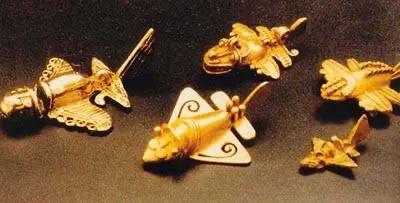The Quimbaya Civilization and Its Artifacts
The Quimbaya civilization, flourishing from 500 BC to 600 AD, was a prominent pre-Columbian culture located in the Middle Cauca River valley and southern Antioquian region of modern-day Colombia. This civilization is renowned for its sophisticated goldsmithing and ceramic works, which have been preserved as significant archaeological finds.
Get your dose of History via Email
Goldsmithing in Quimbaya Artifacts
The Quimbaya artifacts are predominantly crafted from gold, and many utilize a gold-copper alloy known as Tumbaga. This material not only provided a distinctive reddish hue but also enhanced malleability, which was crucial for the intricate designs characteristic of Quimbaya craftsmanship. The lost wax technique, a method known since 4000 BCE, was commonly employed, indicating a high level of technical sophistication.
Ceramic Works
In addition to their gold works, the Quimbaya were also skilled ceramicists. Their ceramics often featured anthropomorphic designs and were used in various cultural rituals, including burials. These artifacts frequently portrayed social classes or notable individuals, serving both functional and symbolic purposes.
The Quimbaya Treasure
A significant collection of these artifacts, known as the Quimbaya Treasure, includes over 400 items such as ceremonial vessels, figurines, and personal ornaments. Discovered in 1890, this treasure provides a comprehensive look at the material culture of the Quimbaya. Unfortunately, many of these items were sold and are currently housed in the Museo de América in Madrid, Spain. Despite legal efforts, these artifacts have not yet been returned to Colombia.
Cultural Significance and Ritual Use
Quimbaya artifacts were not merely decorative but played crucial roles in the social and religious practices of the culture. Gold artifacts, often found in tombs, suggest that gold had a sacred significance and was possibly used to prepare for the afterlife. The Poporo Quimbaya, for example, is a ceremonial gold vessel used for consuming lime during religious rituals involving coca leaves, highlighting its ritual importance.
Controversies and Misinterpretations
The Quimbaya artifacts have not been without controversy, particularly concerning authenticity. The high demand for pre-Columbian artifacts led to the creation of forgeries and mislabeled pieces, complicating the study of genuine Quimbaya culture. Additionally, some artifacts have been misinterpreted, such as the so-called “Quimbaya airplanes,” which are more likely stylized animal figures, misidentified due to pareidolia and popularized by speculative theories.
Conclusion
The Quimbaya artifacts offer invaluable insights into the cultural practices, artistic endeavors, and technological achievements of this ancient civilization. While the preservation and interpretation of these artifacts face challenges, ongoing archaeological and scientific analysis continues to uncover the rich history of the Quimbaya people. It is crucial that these artifacts are studied responsibly and preserved as part of Colombia’s cultural heritage.
Sources:

